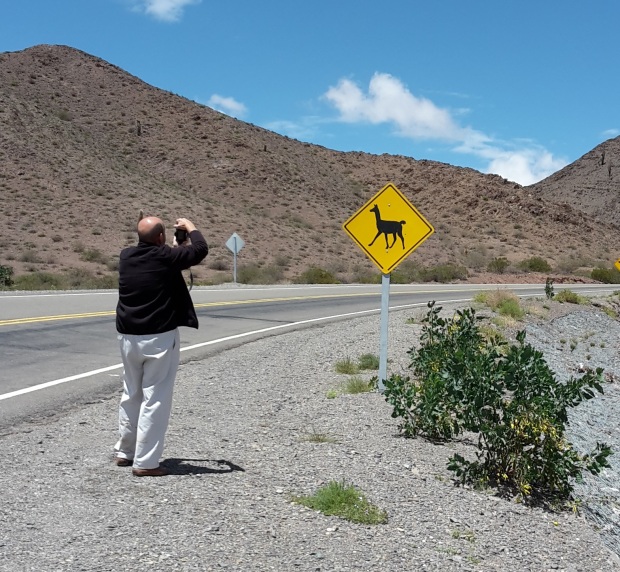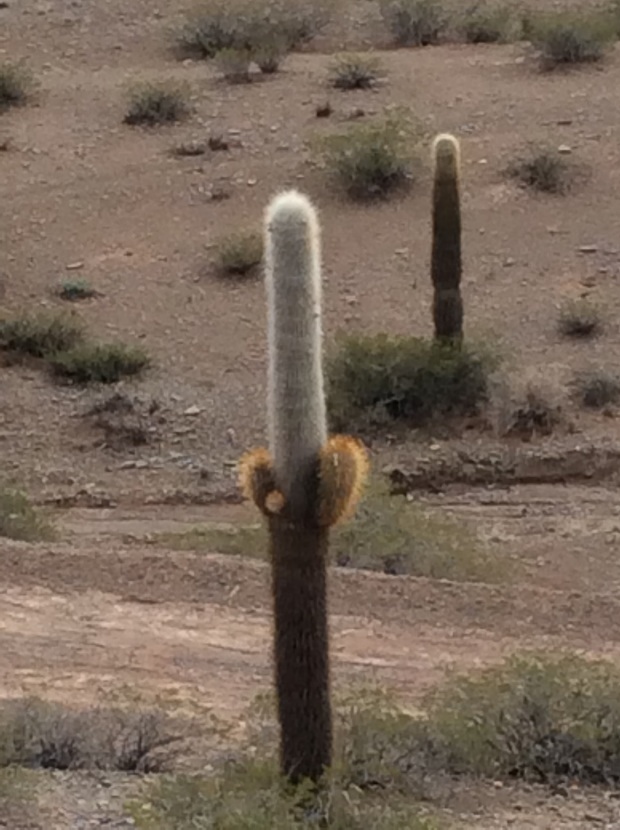While living in Bolivia, in the early part of this century, someone told me a story of the war when Bolivia lost its exit to the Pacific Ocean to Chile. It was apparently during this conflict that a Bolivian General[1], aware that his chances of winning the war were dimming, tried to cheat the incoming Chilean ground forces by dressing the cactuses present in the area with the uniforms of the Bolivian army, pretending that his men were more numerous than they really were! The ruse failed and we all know that Bolivia is now a landlocked country!
I have had the story in my mind since then and recently, when I tried to confirm it by Google for this post, I failed to find any reference to it! In any case, it is a good way of starting to tell you about one of the most emblematic plants that populate parts of the Andean Puna[2], the Cardones [3]. We had a chance to see many of them during our trip to Cachi (Salta Province) that traversed the Los Cardones National Park.

A view over the Los Cardones National Park. Amazing place!

A Cardon forest as far as the eye can see.
The park has an area of 65,000 hectares and it was created in 1987, to preserve a sector of Andean biomasses including the Puna, Pre-Puna and related dry forests. It ranges in altitude from 2,700m (Tin-Tin valley) to 5,000m (Malcante hill). Although it only gets an annual rainfall of less than 200mm, its aridity does not stop many plant and animal species to thrive there, too many to mention here but well described elsewhere [4].
Apart from the cardones there are other interesting finds in the area. In the plant world the Jarilla (Larrea divaricata) provides the cardones with needed shelter for them to grow under its protection until reaching suitable size to continue its growth alone.

A cardon growing under the protection of a Jarilla.
Another amazing plant found at higher altitudes is the haermaphroditic Yareta (Azorella compacta) also known as pasto de piedra [5].This plant is literally a vegetable stone whose leaves develop into an extremely compact and hard mat that reduces heat loss in order to survive. The result is a very rare plant that looks like a giant moss. Of extremely slow growth, some of the specimens in the Puna are estimated to be over 3,000 years old! Unfortunately, because of its slow growth and its traditional harvesting for firewood, it is becoming scarce.
The guanaco (Lama guanicoe) population is not as large as I expected and we only saw three or four groups of these special camelids. Their observed scarcity is apparently the consequence of the competition for food from thousands of feral donkeys (Equus asinus) that once got established there and continue to multiply despite past efforts to control them through culling schemes that will need to be reinstated to give the guanacos a chance to expand. Unfortunately, my pictures of both guanacos and donkeys are still in the deep recesses of my now comatose hard disk!

Guanacos ahead!
Puma (Felix concolor) are present and they predate on the young of both guanacos and donkeys. Luckily, they are seen with certain regularity and the park is one of the areas where the visitor can, if lucky, spot these beautiful cats.
The dead from both donkeys and guanacos are fed upon a number of scavengers among which the condor (Vultur gryphus) is the most prominent and best known. These veritable flying colossus of about one metre in height have a wingspan of three metres or, to be more graphic, a line of about a dozen school children standing side by side! With such wings they can only be superb flying birds, capable not only to cover great distances but also to reach amazing heights.

A condor flying overhead.
I was pleasantly surprised to be able to spot (of course after my wife!) quite a number of condors flying high in the very blue sky. Showing similar skills to African vultures, condors are not easy to spot on the ground as they inhabit and nest in difficult terrain. I am proud to announce, though, that I was able to contribute to our condor observations by spotting a far away nest with a fledgeling! I made sure that my companions noted this but, as usual, my effort was largely ignored.

Although mammals and birds are really fascinating, the cardones were the real stars of the show for me. These very thorny plants are everywhere and they can occur singly, in groups or form true forests that reach as far as the eye can see. Although the majority were very rude by showing me their middle finger, some were polite and welcoming. Admittedly the latter were very few! Clearly, nature comes in all shapes and moods!

A rude cardon!

Exasperated by so much plant rudeness the bushsnob attempts at giving some back…
The cardones start their life under the protection of the Jarilla bush and they produce their first flowers at about fifty years old. These white flowers are known locally as “pasacana” that gives the species name to the plants. The flowers are eaten by animals and people and it is estimated that when the plants reach 3m high they are three hundred years old so some of the ones we spotted must have been much older, probably near one thousand and I never stop from being amazed when watching such creatures that can exist for such a long tie and still look like they would continue being there for another millennium.
[1] I was told that it was President Melgarejo.
[2] Basically a very dry, cold, high and silent area by the Andes mountains.
[3] Spanish for cacti of the species Trichocereus pasacana.
[4] Chebez, J.C. (2012). Noroeste. Guia de las Reservas Naturales de la Argentina. Editorial Albatros. pp. 88-93.
[5] Spanish for stone grass.







